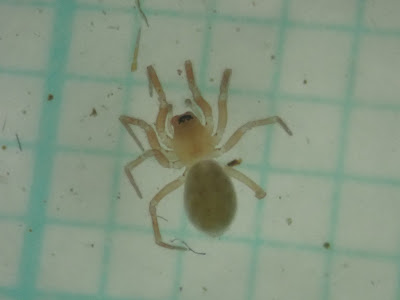There's nothing quite like the smell of Sphagnum on your hands
Posted by Graeme Lyons , Wednesday, 31 January 2024 19:28
I went out on Monday, my first time outside this year (other than the Northern Waterthrush twitch - AKA, shivering in a ditch for five hours on the one day it didn't show well - one of the worst natural history experiences of my life, saved only by bumping into Harry Witts, then dipping the Canvasback then getting detoured the wrong way around the M25). I really needed a day out wandering around a good site with no targets in mind, just the chance of a few good spiders. Typically, I was recording across taxonomic groups but focusing on spiders. I tend to head to the same sites for casual recording, so thought I should try and explore a bit more of Broadwater Warren, as I was last up there in 2020. Now, I did a lot baseline surveying on this site 17 years ago when I worked at the RSPB (but I wasn't really into spiders then), so I am very fond of this site. I spent a bit more time on the open heath on Monday, although I gravitated towards the Sphagnum later.
It didn't take long to find a new site and hectad record for Rhysodromus histrio (above) by sweeping mature Heather. Fantastically camouflaged against the Heather foliage, this really is a heathland obligate - quite a rare thing amongst spiders. Nationally Scarce and restricted in Sussex to the West Sussex heaths and Ashdown Forest. With all the Heather being restored at Broadwater, it's not surprising that this has turned up. I found a second animal a few 100 m away, so good to see it established there. I nearly stood on a Woodock and also found a few Notiophilus quadripunctatus carabids on the scrapes (also a Nationally Scarce species). I thought I had an exciting liny with this little critter, but it was just Gongylidiellum vivum. You can see how small it is - that's an old Heather flower. I headed to the bog.
One of the commonest spiders in the Sphagnum in the bog, I must have seen about 15 or so, was Hahnia pusilla. A tiny spider that I didn't photograph, another Nationally Scarce species. That's more than I have seen in my life, I first recorded it there in early 2020 but only remember seeing one. The other really common specie there, is the money spider Centromerus arcanus. Ashdown Forest and Broadwater Warren are real outliers for this predominantly north-western species. Check out the SRS page for it, no species illustrates better how the High Weald is an 'upland island' in the south east. I also forgot to photo that species too. Then I sieved Euryopis flavomaculata, which is quite the looker (photo below). Yet another Nationally Scarce species.
With my muscles atrophied from four months of sitting at the desk, I was exhausted. Got stuck in some deep Sphagnum and decided to head back. There are some tussocks under Alder carr I remembered but it was hard to access and disappointing suction sampling them. Walking back to the car, I spotted a large patch of lush Sphagnum under pines. I have noticed that when sieving Sphagnum, big thick clumps of Sphagnum palustre are particularly good. I also have a rule; if I see something worth sampling, I have to sample it. It payed off. It almost always pays off. Loads more Hahnia pusilla, Centromerus arcanus, a Heather Shieldbug and an exciting little golden money spider. Little golden money spiders in Sphagnum are almost always exciting. Clearly a Centromerus, I looked at it as soon as I got in.
It was clearly Centromerus cavernarum. Nationally Rare, Near Threatened and new to East Sussex. The last Sussex record was by Dick Jones in 1998 at the very far end of West Sussex. I had hoped to spot this in Beech litter in the Chilterns late last year and have looked for it at many different sites in a casual way, but it was not on my radar for Sphagnum under pines! I love this genus, it's the 9th species I have seen in the genus and my 542nd UK spider! Being my first new species of 2024, my target is to get to at least 550 species by the end of the year! Here is the spider's rather lovely epigyne.












Post a Comment